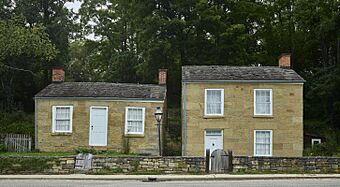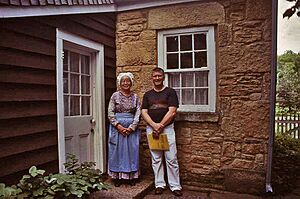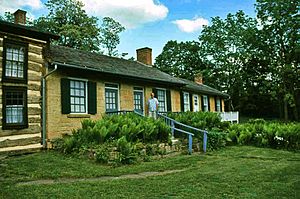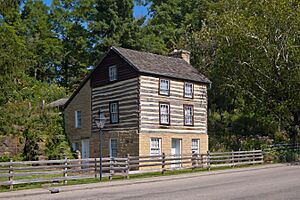Pendarvis (Mineral Point, Wisconsin) facts for kids
Quick facts for kids |
|
|
Pendarvis
|
|

Pendarvis (left) and Trelawny houses (right)
|
|
| Location | 114 Shake Rag St., Mineral Point, Wisconsin |
|---|---|
| Area | 4.6 acres (1.9 ha) |
| Built | 1835 |
| NRHP reference No. | 71000038 |
| Added to NRHP | January 25, 1971 |
Pendarvis is a special historic place in Mineral Point, Wisconsin. It's a collection of old stone and timber houses from the 1800s. These homes were built by immigrants from Cornwall, England, who came to Mineral Point to mine for lead and zinc.
Today, Pendarvis is owned by the Wisconsin Historical Society. It works as a museum that teaches us about Wisconsin's early mining history. The site also highlights the amazing work of Robert Neal and Edgar Hellum, who started saving these buildings during the Great Depression.
Contents
A Look Back: Mining History
Why Miners Came to Mineral Point
In the 1830s and 1840s, many people moved to southwest Wisconsin and northwest Illinois. They came because there was a lot of lead in the ground. Several new towns quickly grew in this area, like Galena, Illinois, Platteville, Wisconsin, and Mineral Point.
Mineral Point became a very busy place during the mining boom. Its population grew to over 4,000 people. Many of these new residents were experienced miners from Cornwall, England. They built simple houses using wood or limestone found nearby.
From Lead to Gold: Miners Move On
Over time, the lead mines started to run out. Many miners then moved to other places, especially California. This happened after gold was discovered there in 1848. Other miners stayed in the area to dig for zinc, which was also plentiful.
However, by the early 1900s, even the zinc mines were being closed down. This meant many of the old mining houses were left empty.
Saving History: The Preservation Story
How Pendarvis Was Saved
By the 1920s and 1930s, many of the old houses built by the Cornish miners were being torn down. A local resident named Robert Neal noticed this. He teamed up with Edgar Hellum to buy and fix up several of these old buildings.
Neal and Hellum gave each restored building a name from the Cornish language. Their first project was a one-story stone house, which they named Pendarvis.
Pendarvis House: A Restaurant with a Mission
To help pay for more restoration work, the Pendarvis House became a restaurant. It served real Cornish dishes, like the famous Cornish pasty. The restaurant became very popular. Its success helped Neal and Hellum restore even more historic Cornish homes in Mineral Point.
Exploring the Historic Buildings
After all the restoration, the Pendarvis historic site included six cabins. These were built by English and Cornish miners in the 1840s and 1850s. The Pendarvis house itself was made from local limestone. Its walls are very thick, about 18 to 20 inches!
Next to Pendarvis is Trelawny, a two-story cottage built in a similar way. Nearby is Polperro, a two-and-a-half-story house. It has a stone first floor and wooden upper floors. Another building is the Rowhouse, which is actually three stone houses connected together. The first two parts were built separately around 1841 and 1844. The third part was built between them around 1852, connecting them all.
Pendarvis Today: A Living Museum
Visiting the Historic Site
In 1970, the collection of buildings saved by Neal and Hellum was given to the Wisconsin Historical Society. A year later, in 1971, Pendarvis opened to the public as a historic site.
Besides the cottages, the Wisconsin Historical Society also acquired land on nearby Merry Christmas Mine Hill. This was once a busy zinc mine. You can still see signs of the old mining activity there. However, much of the hill has been restored to its natural prairie state. Visitors can explore the hill on several walking trails.
What You Can See at Pendarvis
The historic buildings are open to visitors during certain seasons. They serve as a museum that preserves the history of the region's mining industry. You can learn about the lives of the miners who first settled here. Many old items are on display inside the buildings. These include real mining tools and household items from the past.






